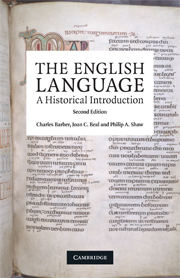Book contents
- Frontmatter
- Contents
- List of figures
- Preface to the second edition
- Preface to the first edition
- Map showing the counties of England
- 1 What is language?
- 2 The flux of language
- 3 The Indo-European languages
- 4 The Germanic languages
- 5 Old English
- 6 Norsemen and Normans
- 7 Middle English
- 8 Early Modern English
- 9 Late Modern English
- 10 English as a world language
- 11 English today and tomorrow
- Notes and suggestions for further reading
- Bibliography
- Index
8 - Early Modern English
- Frontmatter
- Contents
- List of figures
- Preface to the second edition
- Preface to the first edition
- Map showing the counties of England
- 1 What is language?
- 2 The flux of language
- 3 The Indo-European languages
- 4 The Germanic languages
- 5 Old English
- 6 Norsemen and Normans
- 7 Middle English
- 8 Early Modern English
- 9 Late Modern English
- 10 English as a world language
- 11 English today and tomorrow
- Notes and suggestions for further reading
- Bibliography
- Index
Summary
The late Middle Ages had seen the restoration of English as a major literary language in England, and the beginnings of the establishment of a standard form of written English. This did not mean, however, that English was the only language used in England: Latin still had great prestige as the language of international learning, and it was a long time before English replaced it in all fields. Under the influence of the humanists, the grammar-school syllabus was centred on Classical Latin from the early sixteenth century onwards: pupils learned the Latin language, and studied Latin literature, history and rhetoric. In the universities, Latin was the medium of instruction. Even the natural scientists, the proponents of the New Philosophy, often wrote in Latin. The philosopher of the new science, Francis Bacon, wrote his Advancement of Learning (1605) in English, but the book that he intended as his major contribution to scientific method, the Novum Organum (1620), was in Latin. And the three greatest scientific works published by Englishmen between 1600 and 1700 were all in Latin: Gilbert's book on magnetism (1600), Harvey's on the circulation of the blood (1628) and Newton's Principia (1689), which propounded the theory of gravitation and the laws of motion. Even in Newton's time, however, Latin was falling into disuse, and his Opticks (1704) was in English.
- Type
- Chapter
- Information
- The English LanguageA Historical Introduction, pp. 185 - 210Publisher: Cambridge University PressPrint publication year: 2009

